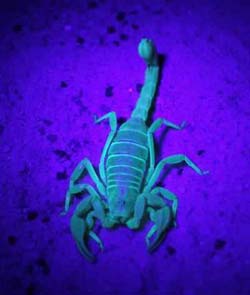Scorpio rising

This is a scorpion glowing under ultraviolet light. This specimen is a Northern Scorpion, a broadly distributed species that was also found in the Inyo Mountains. Credit: Michael Webber<br>
Even in places as seemly well-studied as the national parks of North America, new species are still being discovered. Using ultraviolet light that cause scorpions to fluoresce a ghostly glow, researchers from the University of Nevada, Las Vegas (UNLV) have discovered an intriguing new scorpion in Death Valley National Park. They named the species Wernerius inyoensis, after the Inyo Mountains where it was found. The study was published in the open access journal ZooKeys.
This new species is small, only 16 mm in length. “We almost overlooked this one during the survey” said Matthew Graham, a PhD Candidate with the School of Life Sciences at UNLV. Matt discovered the scorpion along with his father who was volunteering that night. “Only a single male individual was found, but the physical uniqueness was enough to identify it as a new species”, said Michael Webber, another PhD Candidate from UNLV who described the specimen. This new scorpion appears to be closely related to two other species found over 400 kilometers away at Joshua Tree National Park and along the lower Colorado River. This group of scorpions is most easily identified by the presence of a conspicuous spine at the base of the stinger, the function of which, if any, is unknown.
The previously known species are also rarely observed in the wild, and this elusive nature has led to speculation that these scorpions occur at very low densities or have only sporadic surface activity. However, the rocky terrain in which the previous species were found and the discovery of the new species at the base of a talus slope, hint at the possibility that these scorpions are subterrestrial, spending their lives deep in rock crevices or in the interstitial spaces among piles of loose rock.
Scorpions are quite common within arid regions where they can comprise a large component of biological diversity. The new species was discovered during field surveys funded by the National Park Service as part of efforts to develop better inventories for all organisms occurring within the parks.
“In North America, inventories for mammals, birds, reptiles and amphibians are pretty well developed, and we have a good handle on higher-order plants, but for many groups of smaller organisms taxonomic inventories will no doubt lead to numerous new discoveries” said Dr. Jef Jaeger, a Research Assistant Professor at UNLV who initiated and oversaw the scorpion surveys.
In the face of regional environmental changes brought about by human actions and the potential for larger changes that global warming may bring, many scientists and resource managers place new importance on efforts to document and catalog species diversity.
Original source:
Webber MM, Graham MR, Jaeger JR (2012) Wernerius inyoensis, an elusive new scorpion from the Inyo Mountains of California (Scorpiones, Vaejovidae). ZooKeys 177: 1-13. doi: 10.3897/zookeys.177.2562
Posted by Pensoft Publishers.
Media Contact
More Information:
http://www.unlv.nevada.eduAll latest news from the category: Life Sciences and Chemistry
Articles and reports from the Life Sciences and chemistry area deal with applied and basic research into modern biology, chemistry and human medicine.
Valuable information can be found on a range of life sciences fields including bacteriology, biochemistry, bionics, bioinformatics, biophysics, biotechnology, genetics, geobotany, human biology, marine biology, microbiology, molecular biology, cellular biology, zoology, bioinorganic chemistry, microchemistry and environmental chemistry.
Newest articles

A universal framework for spatial biology
SpatialData is a freely accessible tool to unify and integrate data from different omics technologies accounting for spatial information, which can provide holistic insights into health and disease. Biological processes…

How complex biological processes arise
A $20 million grant from the U.S. National Science Foundation (NSF) will support the establishment and operation of the National Synthesis Center for Emergence in the Molecular and Cellular Sciences (NCEMS) at…

Airborne single-photon lidar system achieves high-resolution 3D imaging
Compact, low-power system opens doors for photon-efficient drone and satellite-based environmental monitoring and mapping. Researchers have developed a compact and lightweight single-photon airborne lidar system that can acquire high-resolution 3D…





















